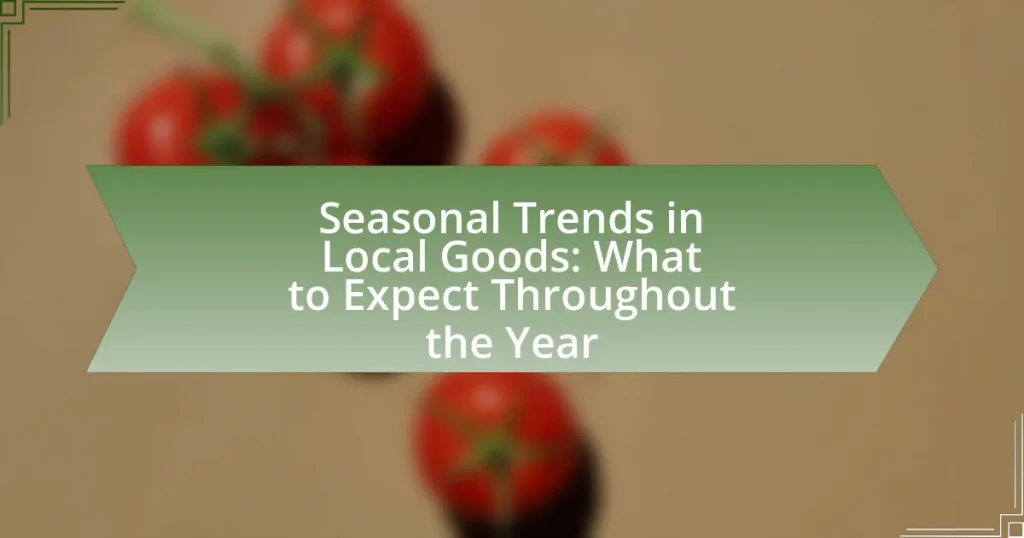Seasonal trends in local goods refer to the variations in demand and availability of products throughout the year, influenced by factors such as climate, holidays, and agricultural cycles. This article explores how these trends impact the availability and pricing of local goods, detailing what consumers can expect in each season, from fresh produce in spring and summer to storage crops in winter. It also examines the role of weather patterns, local events, and consumer behavior in shaping purchasing decisions, highlighting the economic significance of seasonal trends for local markets and communities. Understanding these trends enables consumers to make informed choices, maximize value, and support local economies effectively.

What are Seasonal Trends in Local Goods?
Seasonal trends in local goods refer to the fluctuations in demand and availability of products based on the time of year. For instance, fresh produce such as strawberries peaks in summer, while pumpkins are in high demand during fall. These trends are influenced by factors like climate, holidays, and local agricultural cycles. According to the USDA, seasonal produce availability can significantly affect local markets, with certain items seeing price increases or decreases based on their seasonal harvest. This cyclical pattern helps consumers anticipate what goods will be available and at what price throughout the year.
How do seasonal trends impact local goods availability?
Seasonal trends significantly impact local goods availability by influencing production cycles and consumer demand. For instance, agricultural products are often harvested at specific times of the year, leading to increased availability during harvest seasons and scarcity during off-seasons. According to the USDA, seasonal crops like strawberries peak in availability during late spring and early summer, while winter vegetables are more abundant in colder months. This cyclical pattern affects not only the quantity of goods available but also their pricing, as supply fluctuations can lead to higher prices during periods of scarcity.
What factors influence the seasonal demand for local goods?
Seasonal demand for local goods is influenced by factors such as weather conditions, holidays, and local events. Weather conditions directly affect consumer behavior; for instance, warmer temperatures can increase demand for fresh produce and outdoor products during spring and summer. Holidays, such as Christmas or Thanksgiving, drive demand for specific local goods, including seasonal foods and gifts, as consumers seek to celebrate these occasions. Additionally, local events, such as festivals or farmers’ markets, create spikes in demand for local products, as they attract visitors and encourage community engagement. These factors collectively shape the purchasing patterns of consumers throughout the year.
How do weather patterns affect local goods production?
Weather patterns significantly influence local goods production by affecting agricultural yields, resource availability, and supply chain logistics. For instance, consistent rainfall during the growing season can enhance crop production, while drought conditions can lead to reduced yields and increased prices. According to the National Oceanic and Atmospheric Administration (NOAA), extreme weather events, such as hurricanes or floods, can disrupt supply chains, leading to shortages of goods. Additionally, temperature fluctuations can impact the timing of planting and harvesting, further affecting local markets. Historical data shows that regions experiencing climate variability often see shifts in the types of crops that can be successfully cultivated, thereby altering local economies and food availability.
Why are seasonal trends important for consumers?
Seasonal trends are important for consumers because they influence purchasing decisions and product availability. Understanding these trends allows consumers to align their buying habits with seasonal demand, ensuring they acquire products at optimal times, such as buying winter clothing before the cold season or fresh produce during harvest periods. For example, a study by the National Retail Federation indicates that holiday shopping peaks in November and December, highlighting the importance of timing in consumer behavior. This awareness helps consumers maximize value and satisfaction from their purchases.
How can consumers benefit from understanding seasonal trends?
Consumers can benefit from understanding seasonal trends by making informed purchasing decisions that align with product availability and pricing fluctuations. For instance, seasonal fruits and vegetables are often more affordable and fresher when they are in peak season, leading to cost savings and better quality. Research indicates that consumers can save up to 30% on groceries by purchasing seasonal produce, as highlighted by the USDA’s Seasonal Produce Guide. Additionally, awareness of seasonal trends allows consumers to plan for holidays and events, ensuring they acquire relevant goods at optimal times, thus enhancing their overall shopping experience.
What role do seasonal trends play in local economies?
Seasonal trends significantly influence local economies by driving fluctuations in consumer demand and business activity. For instance, during summer months, tourism-related businesses often experience increased sales due to higher visitor numbers, which can boost local employment and revenue. According to the U.S. Travel Association, domestic travel spending reached $972 billion in 2019, highlighting the economic impact of seasonal tourism. Additionally, agricultural sectors see variations in production and sales based on seasonal cycles, affecting local markets and pricing. These trends create a rhythm in economic activity, shaping employment patterns and local business strategies throughout the year.

What to Expect in Each Season for Local Goods?
In spring, expect a variety of fresh vegetables such as asparagus, peas, and radishes, along with early fruits like strawberries. These items are typically harvested from March to June, aligning with the growing season in many regions.
During summer, local goods include a wide array of fruits and vegetables, such as tomatoes, cucumbers, and berries, which thrive in warmer temperatures from June to August. This season is known for its abundance of produce due to optimal growing conditions.
In autumn, local goods shift to heartier crops like pumpkins, apples, and root vegetables, which are harvested from September to November. This season marks the transition to cooler weather and the end of the growing season for many crops.
Winter brings a focus on storage crops such as potatoes, carrots, and winter squash, which can be harvested in late fall and stored for use throughout the winter months. These goods are available from December to February, reflecting the seasonal limitations of fresh produce during colder months.
What local goods are typically available in spring?
Local goods typically available in spring include fresh produce such as asparagus, strawberries, and peas. These items are harvested during the spring months, making them abundant in local markets. For instance, strawberries are often in season from late March to June in many regions, while asparagus is usually available from April to June. This seasonal availability is supported by agricultural reports that highlight the peak harvest times for these crops, confirming their presence in local goods during spring.
Which fruits and vegetables are in season during spring?
During spring, fruits and vegetables such as strawberries, asparagus, peas, radishes, and rhubarb are in season. These items are typically harvested from March to June, depending on the region. For example, strawberries are known to peak in late spring, while asparagus is one of the first vegetables to be harvested in the season. This seasonal availability is influenced by climate conditions and agricultural practices, making these produce items fresh and flavorful during this time.
How do local artisans contribute to spring goods?
Local artisans contribute to spring goods by creating unique, handcrafted items that reflect seasonal themes and local culture. Their work often includes producing seasonal decorations, such as floral arrangements and garden ornaments, which enhance the aesthetic appeal of spring. Additionally, artisans may craft clothing and accessories using lightweight fabrics and vibrant colors that align with spring trends. According to a report by the Craft Industry Alliance, handmade goods have seen a 25% increase in demand during the spring season, highlighting the significant role artisans play in meeting consumer preferences for unique, locally-sourced products.
What local goods are typically available in summer?
Local goods typically available in summer include fresh fruits, vegetables, and artisanal products. During this season, farmers’ markets often showcase seasonal produce such as tomatoes, corn, berries, and melons, which are harvested at their peak ripeness. Additionally, local dairies may offer fresh cheeses and ice creams made from summer ingredients. The availability of these goods is supported by agricultural cycles, as summer is a prime growing season in many regions, leading to an abundance of fresh, locally sourced options.
What are the popular summer festivals featuring local goods?
Popular summer festivals featuring local goods include the Farmers’ Market at the Park in various cities, which showcases regional produce and artisanal products. Additionally, the Taste of Summer Festival, held in numerous locations, highlights local culinary offerings and crafts. These festivals typically attract thousands of visitors, supporting local economies and promoting community engagement. For instance, the National Cherry Festival in Traverse City, Michigan, celebrates local cherry harvests and features local vendors, drawing over 500,000 attendees annually.
How does tourism affect the availability of summer local goods?
Tourism significantly increases the demand for summer local goods, leading to a higher availability of these products in tourist-heavy areas. As visitors flock to destinations during the summer months, local businesses often ramp up production and supply of seasonal goods, such as fresh produce, crafts, and souvenirs, to cater to the influx of consumers. For instance, a study by the World Tourism Organization indicates that regions with high tourist traffic experience a 30% increase in local goods sales during peak seasons, demonstrating a direct correlation between tourism and the availability of these goods.
What local goods are typically available in autumn?
Local goods typically available in autumn include apples, pumpkins, and various root vegetables. During this season, apple orchards often yield a variety of apple types, which are harvested for fresh consumption and cider production. Pumpkins become widely available as they are harvested for decoration and culinary uses, particularly in pies and soups. Additionally, root vegetables such as carrots, beets, and potatoes are harvested in autumn, providing fresh produce for local markets. These goods reflect the seasonal agricultural cycle and are commonly found at farmers’ markets and grocery stores during this time of year.
What seasonal events highlight autumn local goods?
Autumn local goods are prominently highlighted during seasonal events such as harvest festivals, farmers’ markets, and craft fairs. Harvest festivals celebrate the season’s bounty, showcasing locally grown produce like apples, pumpkins, and squash, while farmers’ markets provide a platform for local farmers to sell their seasonal products directly to consumers. Craft fairs often feature handmade goods that reflect autumn themes, including seasonal decorations and artisanal foods. These events not only promote local agriculture and craftsmanship but also foster community engagement and support for local economies.
How do harvest cycles influence autumn goods?
Harvest cycles significantly influence autumn goods by determining the availability and variety of produce during this season. As crops reach maturity in late summer and early fall, farmers harvest fruits, vegetables, and grains, which directly impacts the types of goods available in local markets. For instance, the harvest of apples, pumpkins, and squash typically peaks in autumn, leading to an abundance of these items in grocery stores and farmers’ markets. This seasonal availability is supported by agricultural data indicating that many staple crops are specifically cultivated to be ready for harvest in the fall, aligning with consumer demand for seasonal products.
What local goods are typically available in winter?
Local goods typically available in winter include seasonal produce such as root vegetables, citrus fruits, and hardy greens. During winter months, root vegetables like carrots, potatoes, and turnips are harvested and readily available, as they thrive in colder temperatures. Citrus fruits, including oranges and grapefruits, are also in season, providing a fresh source of vitamin C during the winter. Additionally, hardy greens like kale and collard greens can withstand frost and are often harvested in winter, making them popular local goods during this season.
What are the key holiday markets for winter local goods?
Key holiday markets for winter local goods include the Christkindlmarkt in Nuremberg, Germany, and the Union Square Holiday Market in New York City, USA. The Christkindlmarkt, established in the 16th century, features local artisans selling handmade crafts and traditional foods, attracting over two million visitors annually. The Union Square Holiday Market showcases local vendors offering unique gifts, food, and crafts, contributing to the local economy and supporting small businesses during the holiday season. These markets exemplify the trend of promoting local goods during winter festivities.
How do winter weather conditions affect local goods supply?
Winter weather conditions significantly disrupt local goods supply by causing transportation delays and increasing operational costs. Snow, ice, and severe cold can hinder the movement of goods, leading to delays in deliveries and shortages in inventory. For instance, the U.S. Department of Transportation reported that winter storms can reduce road capacity by up to 50%, impacting logistics and distribution networks. Additionally, businesses may face increased costs due to the need for snow removal and heating, which can further strain supply chains. These factors collectively result in reduced availability of local goods during winter months.

How Can Consumers Navigate Seasonal Trends in Local Goods?
Consumers can navigate seasonal trends in local goods by staying informed about local harvest schedules and seasonal product availability. By following local farmers’ markets, subscribing to newsletters from local producers, and utilizing apps that track seasonal produce, consumers can make timely purchasing decisions. Research indicates that seasonal buying not only supports local economies but also enhances the freshness and quality of goods, as items are often harvested at their peak. For example, the USDA reports that seasonal fruits and vegetables have higher nutrient content and better flavor compared to out-of-season imports.
What strategies can consumers use to take advantage of seasonal trends?
Consumers can take advantage of seasonal trends by planning purchases around peak times for specific products, utilizing sales events, and engaging in local markets. For instance, buying seasonal produce during harvest times ensures freshness and often lower prices, as seen in the increased availability of fruits and vegetables during summer months. Additionally, consumers can benefit from holiday sales, such as Black Friday or end-of-season clearances, which typically offer significant discounts on seasonal items. Engaging with local farmers’ markets during peak seasons allows consumers to access fresh, local goods while supporting the community. These strategies enable consumers to maximize value and quality in their purchases throughout the year.
How can consumers plan their purchases around seasonal availability?
Consumers can plan their purchases around seasonal availability by researching and understanding the seasonal cycles of local goods. For instance, fruits and vegetables have specific harvest seasons; strawberries peak in late spring, while pumpkins are abundant in fall. By aligning their shopping habits with these cycles, consumers can ensure they buy fresh, in-season products, which are often more affordable and flavorful. Studies show that seasonal produce can be up to 30% cheaper when purchased at peak times, reinforcing the economic benefits of this approach. Additionally, consumers can utilize local farmers’ markets, which typically feature seasonal offerings, allowing them to make informed purchasing decisions based on availability.
What resources are available for tracking seasonal trends in local goods?
Resources for tracking seasonal trends in local goods include agricultural extension services, local farmers’ markets, and online platforms like Google Trends. Agricultural extension services provide data on crop cycles and seasonal availability, helping consumers understand when specific goods are in season. Local farmers’ markets often publish seasonal calendars that outline the availability of local produce and goods throughout the year. Additionally, Google Trends allows users to analyze search interest over time for specific products, revealing seasonal patterns in consumer demand. These resources collectively offer valuable insights into the timing and availability of local goods.
What are the best practices for supporting local goods throughout the year?
To support local goods throughout the year, consumers should prioritize purchasing from local farmers’ markets, artisan shops, and community-supported agriculture programs. Engaging with these local businesses fosters economic growth within the community, as studies show that local businesses recirculate a greater share of every dollar as they create locally owned supply chains and invest in their employees. Additionally, consumers can participate in local events and festivals that showcase local products, which not only promotes awareness but also strengthens community ties. Research indicates that communities with strong local business networks experience higher levels of economic resilience and social cohesion.
How can consumers engage with local producers effectively?
Consumers can engage with local producers effectively by participating in farmers’ markets and community-supported agriculture (CSA) programs. These platforms allow consumers to directly purchase fresh, seasonal goods while fostering relationships with producers. Research indicates that farmers’ markets contribute to local economies by generating approximately $1.5 billion in sales annually in the United States, highlighting their significance in connecting consumers with local food sources. Additionally, engaging through social media and local food events can enhance awareness and support for local producers, creating a sustainable cycle of consumption and production.
What are the benefits of buying local goods seasonally?
Buying local goods seasonally supports local economies and promotes sustainability. When consumers purchase seasonal products from local producers, they contribute to the financial stability of their communities, which can lead to job creation and economic growth. Additionally, seasonal goods often require less transportation, reducing carbon emissions associated with long-distance shipping. Research indicates that local food systems can decrease greenhouse gas emissions by up to 25% compared to imported goods. Furthermore, seasonal products are typically fresher and more nutritious, as they are harvested at their peak ripeness, enhancing both flavor and health benefits.




